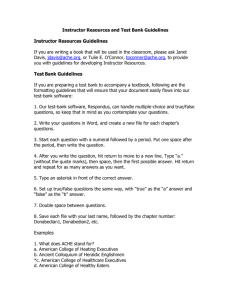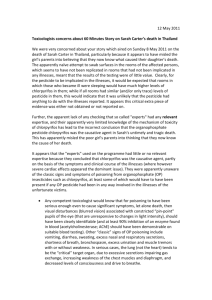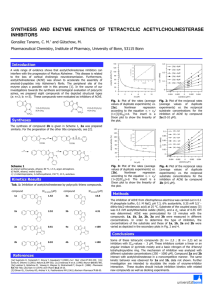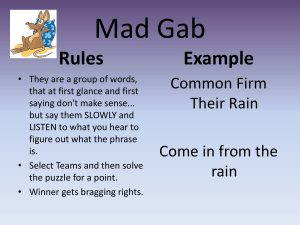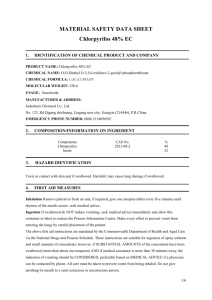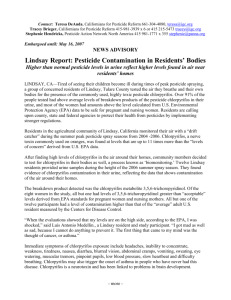kinetic investigation into the interaction of chlorpyrifos and thiodicarb
advertisement
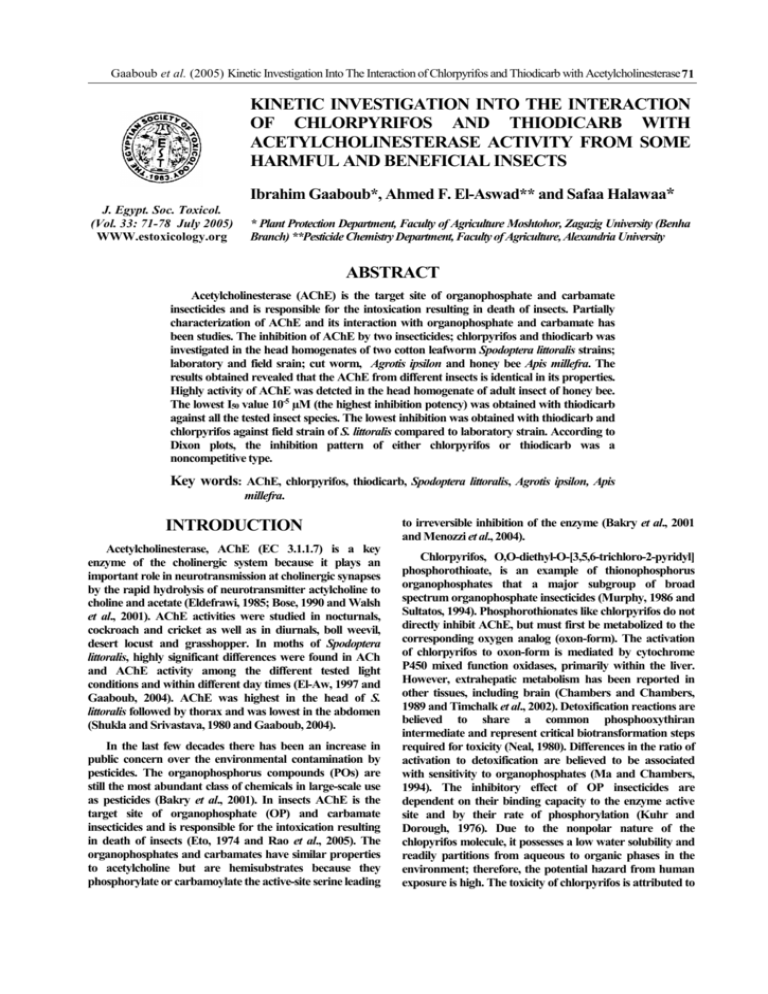
Gaaboub et al. (2005) Kinetic Investigation Into The Interaction of Chlorpyrifos and Thiodicarb with Acetylcholinesterase 71 KINETIC INVESTIGATION INTO THE INTERACTION OF CHLORPYRIFOS AND THIODICARB WITH ACETYLCHOLINESTERASE ACTIVITY FROM SOME HARMFUL AND BENEFICIAL INSECTS Ibrahim Gaaboub*, Ahmed F. El-Aswad** and Safaa Halawaa* J. Egypt. Soc. Toxicol. (Vol. 33: 71-78 July 2005) WWW.estoxicology.org * Plant Protection Department, Faculty of Agriculture Moshtohor, Zagazig University (Benha Branch) **Pesticide Chemistry Department, Faculty of Agriculture, Alexandria University ABSTRACT Acetylcholinesterase (AChE) is the target site of organophosphate and carbamate insecticides and is responsible for the intoxication resulting in death of insects. Partially characterization of AChE and its interaction with organophosphate and carbamate has been studies. The inhibition of AChE by two insecticides; chlorpyrifos and thiodicarb was investigated in the head homogenates of two cotton leafworm Spodoptera littoralis strains; laboratory and field srain; cut worm, Agrotis ipsilon and honey bee Apis millefra. The results obtained revealed that the AChE from different insects is identical in its properties. Highly activity of AChE was detcted in the head homogenate of adult insect of honey bee. The lowest I50 value 10-5 µM (the highest inhibition potency) was obtained with thiodicarb against all the tested insect species. The lowest inhibition was obtained with thiodicarb and chlorpyrifos against field strain of S. littoralis compared to laboratory strain. According to Dixon plots, the inhibition pattern of either chlorpyrifos or thiodicarb was a noncompetitive type. Key words: AChE, chlorpyrifos, thiodicarb, Spodoptera littoralis, Agrotis ipsilon, Apis millefra. INTRODUCTION Acetylcholinesterase, AChE (EC 3.1.1.7) is a key enzyme of the cholinergic system because it plays an important role in neurotransmission at cholinergic synapses by the rapid hydrolysis of neurotransmitter actylcholine to choline and acetate (Eldefrawi, 1985; Bose, 1990 and Walsh et al., 2001). AChE activities were studied in nocturnals, cockroach and cricket as well as in diurnals, boll weevil, desert locust and grasshopper. In moths of Spodoptera littoralis, highly significant differences were found in ACh and AChE activity among the different tested light conditions and within different day times (El-Aw, 1997 and Gaaboub, 2004). AChE was highest in the head of S. littoralis followed by thorax and was lowest in the abdomen (Shukla and Srivastava, 1980 and Gaaboub, 2004). In the last few decades there has been an increase in public concern over the environmental contamination by pesticides. The organophosphorus compounds (POs) are still the most abundant class of chemicals in large-scale use as pesticides (Bakry et al., 2001). In insects AChE is the target site of organophosphate (OP) and carbamate insecticides and is responsible for the intoxication resulting in death of insects (Eto, 1974 and Rao et al., 2005). The organophosphates and carbamates have similar properties to acetylcholine but are hemisubstrates because they phosphorylate or carbamoylate the active-site serine leading to irreversible inhibition of the enzyme (Bakry et al., 2001 and Menozzi et al., 2004). Chlorpyrifos, O,O-diethyl-O-[3,5,6-trichloro-2-pyridyl] phosphorothioate, is an example of thionophosphorus organophosphates that a major subgroup of broad spectrum organophosphate insecticides (Murphy, 1986 and Sultatos, 1994). Phosphorothionates like chlorpyrifos do not directly inhibit AChE, but must first be metabolized to the corresponding oxygen analog (oxon-form). The activation of chlorpyrifos to oxon-form is mediated by cytochrome P450 mixed function oxidases, primarily within the liver. However, extrahepatic metabolism has been reported in other tissues, including brain (Chambers and Chambers, 1989 and Timchalk et al., 2002). Detoxification reactions are believed to share a common phosphooxythiran intermediate and represent critical biotransformation steps required for toxicity (Neal, 1980). Differences in the ratio of activation to detoxification are believed to be associated with sensitivity to organophosphates (Ma and Chambers, 1994). The inhibitory effect of OP insecticides are dependent on their binding capacity to the enzyme active site and by their rate of phosphorylation (Kuhr and Dorough, 1976). Due to the nonpolar nature of the chlopyrifos molecule, it possesses a low water solubility and readily partitions from aqueous to organic phases in the environment; therefore, the potential hazard from human exposure is high. The toxicity of chlorpyrifos is attributed to 72 Gaaboub et al. (2005) Kinetic Investigation Into The Interaction of Chlorpyrifos and Thiodicarb with Acetylcholinesterase inhibition of the AChE enzyme (Rack, 1993 and Farag et al., 2003). insecticides chlorpyrifos and thiodicarb were 99.2 % from the Chem. Service, Inc and 99.0 %, respectively. Thiodicarb, dimethyl N, N’- [thiobis (methyliminocarbonyloxy)] bis-(ethanimido-thiolate), is an example of a sulfenylated biscarbamate insecticide. The molecule has an approximate twofold axis through the central S atom, which joins the two methyliminocarbonyloxyethanimidothiolate units. One of the two arms is planar in the crystal. Semi-empirical geometry optimization for an isolated molecule favors a model with both arms planar and, thus, crystal packing may be responsible for the observed nonplanarity in one arm. Bond lengths and angles have similar values to those of the 'monomeric' carbamate insecticide methomyl (Ammon et al., 1995). AChE of the house fly resistant strain was several times more resistant to inhibition by carbamates than the enzyme of a susceptible strain or a strain with only metabolic resistance to insecticides (Karunaratne and Plapp, 1993). AChE from German cockroaches was partially characterized and examined for its possible involvement in resistance to organophosphate and carbamate insecticides in four resistant strains. The biomolecular rate constants, ki, in four stains of German cockroaches which display varying levels of organophosphate and carbamate resistance were similar to the susceptible strain for chlorpyrifos oxon, malaoxon, and propoxur, suggesting that insensitivity of AChE in German cockroaches is probably not a common factor conferring resistance to these compounds (Siegfried and Scott, 1990). Preparation of homogenates: The first objective of the present study was to compare the AChE activities isolated from harmfull insects; cotton leafworm (S. littoralis) and cut worm (Agrotis ipsilon) and benificial insect, honey bee (Apis millfera). Second objective was to investigate the kinetic of AChE with factors affecting the enzyme activity in order to justify the assay condition. In addition, the in vitro interaction of chlorpyrifos and thiodicarb with isolated enzyme. MATERIALS AND METHODS Tested Insect: Susceptible strain of S. littoralis (Boisd.) and A. ipsilon were obtained from a stock culture maintained under constant conditions 26.0 + 2.0 ْC, 70.0 + 5.0 % relative humidity in the Department of Entomology, Faculty of Agriculture Moshtohor. The cultures were reared on castor leaves. The field strain of S. littoralis was collected from Elbehira Governorate (Abo-Hommos). The A. millfera sample was obtained from the department of Entomology, faculty of Agriculture Moshtohor. Chemicals: All the reagents used in the present study were of analytical grade and used without any further purification. Acetylthiocholine iodide (ATChI) and 5,5--dithiobis(2nitrobenzoic acid)(DTNB) were purchased from the SigmaAldrich chemical company, USA. The two technical grade Head capsule of the different insects (0.8 g) were collected and homogenized in 8 ml 0.1M phosphate buffer (pH 7) under ice conditions. The homogenates were centrifuged for 20 min at 6000 g and 4 Co. The supernatants were obtained as enzyme source. Determination of protein and AChE activity: Protein was determined according to the protein-dye binding method of Bradford (1976), which was prepared by dissolving 100 mg of Coomassie Brilliant Blue G-250 in 50 ml 95% ethanol and 100 ml 85% (w/v) phosphoric acid made the dye solution. To 5 ml of this solution, 0.1-ml homogenate preparation was added, and the contents were mixed by vortexing. Absorbance was measured at 595 nm against a reagent blank using a Spectronic 21D Spectrophotometer. The concentration was estimated from a standard curve of concentrations of bovine serum albumin (BSA). Acetylcholinesterase activity was determined by measuring the rate of hydrolysis of acetylcholine iodide (3X10-3 M) in 0.1M sodium phosphate buffer (pH 8) according to Ellman et al. (1961). Kinetic and inhibition study: The AChE activity was measured with different substrate concetrations; 0.250, 0.375, 0.500, 0.625, 0.750 and 1 mM acetylthiocholine iodide (ATChI). Also The activity was recorded with different protein levels; 0.01, 0.02, 0.03, 0.04, 0.05 and 0.06 mg for tested insects except the samples of bee homogenates which investigated with; 0.001, 0.002, 0.003, 0.004, 0.005 and 0.006 mg protein. The inhibition of AChE by chlorpyrifos and thiodicarb was studied with concentrations; 0.0001, 0.001, 0.01, 0.1 and 1.0 nM. The Dixon plot was drawn by plotting 1/V versus different concentrations of chlorpyrifos and thiodicarb (nM) with 0.5 and 1.5 mM ATChI. The inhibition studies were analyzed by the non-linear regression analysis (Munson and Rodbard, 1980). RESULTS AND DISCUSSION Effect of substrate concentrations on the AChE activity: Fig. (1) shows the intial velocity of AChE activity determind at various concentrations of ATChI under the standerd condictions (incubation at 37oC for 20 min.). The trend of the AChE activities from different insects with various ATChI concentrations is almost the same. The heighest enzyme reaction velocity was in the case of bee homogenate (Fig. 1C). No staturation was observed for all curves, but above 0.75 mM of ATChI slighty decrease in activity was observed. Based on the results, the chosen concentration of ATChI in the standard asssay was to be 0.5 mM. Increasing concentration of substrate (ATChI) Gaaboub et al. (2005) Kinetic Investigation Into The Interaction of Chlorpyrifos and Thiodicarb with Acetylcholinesterase 73 0.5 (A) V(Absorbance/mg protein/min) V(Absorbance/mg protein/min) 0.5 0.4 0.3 0.2 0.1 0.4 0.3 0.2 0.1 0 0 0 0.2 0.4 [ATChI] mM 0.6 1 0 0.8 (C) 0.2 0.4 [ATChI] mM 0.6 0.8 0.5 V(Absorbance/mg protein/min) V(Absorbance/mg protein/min) (B) 0.8 0.6 0.4 0.2 0 (D) 0.4 0.3 0.2 0.1 0 0 0.2 0.4 0.6 [ATChI] mM 0.8 0 0.2 0.4 0.6 0.8 [ATChI] mM Fig. (1): Effect of substrate concentration on the assay (A: succeptibile cotton leafworm, B: field cotton leafworm, C: honey bee and D: cut worm). increased the hydrolysis rate to a maximum and then activity was declined (Dixon and Webbs, 1964 and Kassem, 2002). Also, the obtained results are similar to those mentioned by El-Shahawi and Al-Rajhi (2000). They measured the activity of glutathione S-transferase and found that no staturation was observed for Odinitrobenzene (DNB) and its concentration was chosen to be 0.5 mM in standard assay. Proportionality of activity to enzyme concentration: Data in Fig. (2) show typical results estimated by the srandard assay method with a crude extract of AChE obtained from S. littoralis, A. ipsilon and A. millefra. The activity of the enzyme extract was determind at various protein concentrations, ranged from 0.01 to 0.07 mg for the two strains of S. littoralis and A. ipsilon and ranged from 0.001 to 0.007 mg for honey bee homogenate under the standard conditions (incubation at 37 oC for 20 min.) using 0.5 mM ATChI as a substrate. It is indicated that the enzyme unit was higher in A. millfera homogenate than in homogenate of S. littoralis and A. ipsilon. Determination of the optimum enzyme and substrate concentrations revealed that the activity of AChE was increased with the increase in the protein concentration. This finding is agreable with Kassem (2002) who found that the rate of acetycholine hydrolsis was increased proportionally in relation to protein concentration. Inhibitory action and kinetics studies inhibited AChE by chlorpyrifos and thiodicarb: AChE from different insects was titrated with increasing concentrations of chlorpyrifos and thiodicarb. Data in Fig. (3) show that AChE obtained from all tested insect species was more inhibited by thiodicarb than by chlorpyrifos. The lowest I50 value 10-5 µM (the highest inhibition potency) was obtained with thiodicarb against all 0.5 (A) 0.4 0.3 0.2 0.1 0 0 0.02 0.04 Protein (mg) 0.06 V (Absorbance/mg protein/min) V (Absorbance/mg protein/min) 74 Gaaboub et al. (2005) Kinetic Investigation Into The Interaction of Chlorpyrifos and Thiodicarb with Acetylcholinesterase (B) 0.4 0.3 0.2 0.1 0 0.08 0 0.02 0.04 0.06 0.08 Protein (mg) 1.2 0.5 (C) 1 0.8 0.6 0.4 0.2 0 V (Absorbance/mg protein/min) V (Absorbance/mg protein/min) 0.5 (D) 0.4 0.3 0.2 0.1 0 0 0.002 0.004 0.006 0.008 Protein (mg) 0 0.02 0.04 0.06 0.08 Protein (mg) Fig. (2): Standard curve for assay of the AChE (A: succeptibile cotton leafworm, B: field cotton leafworm, C: honey bee and D: cut worm). the tested insect species. Chlorpyrifos exerted weak inhibitory effect against AChE of tested insect species. The inhibition differences between the two tested compounds may be attributed to the difference in their structure. Thus, the potent tested compound is thiodicarb. Phosphorothionates like chlorpyrifos do not directly inhibit AChE, but must first be metabolized to the corresponding oxygen analog (chlorpyifos-oxon) (Chambers and Chambers, 1989; Guengerich, 1977 and Timchalk et al., 2002). Intestinal cells contain P-glycoproteins that react to chlorpyrifos-oxon, and would likely be an additional barrier to oxon absorption (Lanning et al., 1996). The relation between OP activation and detoxification is of critical importance in determining the toxicological response to OP insecticides (Ma and Chambers, 1994). Furthermore, the highest inhibition potency was obtained with methomyl followed by two tested organophosphorus compounds; monocrotophos and methyl parathion (Kassem, 2002). The lowest inhibition was obtained with thiodicarb and chlorpyrifos against field strain of S. littoralis compared to laboratory strain (Fig., 3A&B) of the same species. The sensetivity of AChE obtained from laboratory strains of S. littoralis and cut worm to thiodicarb and chlorpyrifos was almost the same Fig. (3A&D). Biochemical analysis has been extensively used to characterize the resistance of field population and laboratory strains of S. littoralis (Mostafa et al., 1976; El-Gendy et al., 1985; Marzouk, 1990 and Osman et al., 1994). AChE, the specific esterase hydrolzing acetylcholine ester is also suggested to be involved in the development of the acquired resistance to OP and carbamate insecticides (Watanabe et al., 1988). ChE activities of S. littoralis Abo-Hommos field strain recorded about 5.6 times of that of the laboratory strain (El-Aw et al., 2002). AChE insensitve to OP and carabamate insecticides has been identified as a major resistance mechanism in numerous arthropod species (Walsh et al., 2001 and Ma and Chambers, 1995). In addition, Ishaaya and Klein (1990) found that S. littoralis larvae collected from a cotton field that was heavily sprayed with conventional insecticides showed strong resistance to OPs wherease the LC50 of the field strain was 120 times more resistant than the laboratory strain to chlorpyrifos. Mascarenhas et al. (1998) found that several field strains of beet armyworm, S. exigua (Hubner), exhibited reduced suscetibility to chlorpyrifos and thiodicarb. Gaaboub et al. (2005) Kinetic Investigation Into The Interaction of Chlorpyrifos and Thiodicarb with Acetylcholinesterase 75 Chlorpyrifos 80 Thiodicarb 60 Chlorpyrifos 40 80 Thiodicarb لوغاريتمي (bracidoihT) 20 لوغاريتمي (sofiryprolhC) 0 لوغاريتمي (bracidoihT) 1.E-05 1.E-03 1.E-01 1.E+01 1.E+03 1.E+05 لوغاريتمي (sofiryprolhC) Conc. (µM) 1.E-03 1.E-01 1.E+01 1.E+03 1.E+05 Conc. (µM) (D) 100 80 Inhibition % Inhibition % 40 0 1.E-05 80 60 40 60 40 20 20 0 1.E-05 60 20 (C) 100 (B) 100 (A) Inhibition % Inhibition % 100 1.E-03 1.E-01 1.E+01 1.E+03 1.E+05 0 1.E-05 1.E-03 1.E-01 1.E+01 1.E+03 1.E+05 Conc. (µM) Conc. (µM) Fig. (3): Inhibition of AChE by chloropyrifos and thiodicarb (A: succeptibile cotton leafworm, B: field cotton leafworm, C: honey bee and D: cut worm). Table (1): The I50 (μM) values of tested insecticides against AChE activity of different insect species. Numbers are micromolar concentration of inhibitor at which 50% of the uninhibited activity remains Insecticides Chlorpyrifos Thiodicarb S. littoralis Laboratory strain 102 10-3 From the data obtained, it was clear that thiodicarb was the strongest inhibitor against AChE of all the insect species followed by chlorpyrifos. The lowest I50 values were 10-5 μM for thiodicarb and 1 μM for chlorpyrifos against honey bee AChE while the highest I50 values were 10-2 μM for thiodicarb and 107 μM for chlorpyrifos on field strain of S. littoralis (Table 1). The inhibition was analyzed graphically by means of Dixon plots Figs. (4 and 5). The effect of different concentrations of chlorpyrifos and thiodicarb on the honey bee AChE was investigated in assay containing 0.5 mM and 1.5 mM of ATChI as a substrate. Apparent inhibition constant (ki) for the chlorpyrifos Fig. (4A) and thiodicarb S. littoralis Field strain 107 10-2 A. millfera A. ipsilon 1 10-5 50 10-4 Fig. (4B) reached 1000 nM [calculated by Y= 0.059 Ln (x) – 0.0108, R2 = 0.9944] and 0.0001 nM [calculated by Y= 0.1965 Ln (x) + 0.0468, R2 = 0.9982], respectively. Also, the activity of AChE obtained from cut worm was determind in assay containing .05 mM and 1.5 mM substrate against chlorpyrifos Fig. (5A) and thiodicarb Fig. (5B). The values of ki constant reached 1000 nM [calculated by Y= 0.0634 Ln (x) + 0.0147, R2 = 0.998] and 0.001 nM [calculated by Y= 0.1885 Ln (x) + 0.4585, R2 = 0.999] for chlorpyrifos and thiodicarb, respectively. AChE has low affinity for OP inhibition, (Km in the 0.1mM range). It is the irrevesible nature of inhibition by such OP and aging of AChE that results in submicromolars ki values and makes then highly toxic (Eldefrawi, 1985). 76 Gaaboub et al. (2005) Kinetic Investigation Into The Interaction of Chlorpyrifos and Thiodicarb with Acetylcholinesterase Fig. (4): Dixon plot: Effect of different concentrations of chlorpyrifos (A) and thiodicarb (B) on the AChE activity from Abis milfera (Activity was determined in assay containing 0.5 mM and 1.5 mM substrate) Fig. ( 5 ): Dixon plot: Effect of different concentrations of chlorpyrifos (A) and thiodicarb (B) on the AChE activity from cut worm Agrotis ipsilon (Activity was determined in assay containing 0.5 mM and 1.5 mM substrat Gaaboub et al. (2005) Kinetic Investigation Into The Interaction of Chlorpyrifos and Thiodicarb with Acetylcholinesterase 77 Clearly, the pervious results of Dixon plots Figs. (4 and 5) indicated that, the inhibition pattern of either chlorpyrifos or thiodicarb was a noncompetitive type. It is concluded that the AChE obtained from tested beneficial and harmful insects is identical in its properties. Highly activity of AChE was detcted in the head homogenate of adult insect of honey bee. Thiodicarb was the strongest inhibitor against AChE of all the insect species followed by chlorpyrifos. thiodicarb was the strongest inhibitor against AChE of all the insect species followed by chlorpyrifos. The lowest inhibition was obtained with thiodicarb and chlorpyrifos against field strain of S. littoralis compared to laboratory strain. Dixon plots indicated that the inhibition pattern of chlorpyrifos and thiodicarb was a noncompetitive type. REFERENCES Ammon, H.L.; R.J. Seymour; W.M. Huffman and T.D. D’Silva (1995). Thiodicarb. Acta Crystallogr C. 8:16191621. Bakry, N.M.; K.A. Osman; A.F. El-Aswad s; Kh.Y. AbdelHalim and M.B. AboDonia (2001). Biomonitoring of pesticide contanination from the pesticide industry. J. Egypt. Soc. Toxicol., 24:107-111. Bose, C. (1990). In vivo inhibition of acetylcholinesterase by carbamate and organophosphorous pesticides in the cockroach Periplaneta americana. Biol. Mem. 16(1/2):66-70. Bradford M.M. (1976). A rapid and sensitive method for the quantitative microgram quantities utilizing the principle of protein-dye binding. Anal. Biochem., 72:248-254. Chambers, J.E. and J.W. Chambers (1989). Oxidative desulfuration of chlorpyrifos, chlorpyrifos-methyl, and leptophos by rat brain and liver. J. Biochem. Toxicol. 4: 201–203. Dixon, M. and E.C. Webb (1964). Enzymes, Longmans, and London pp. 950. El-Aw, M.A. (1997). Further physiological studies on the CNS of insects Ph.D. Thesis, Faculty of Agriculture, University of Alexandria, Egypt. El-Aw, M.A.; M.A. Marzouk and M. Hashem (2002). Determination and biochemical characterization of resistance in the field strains of the cotton leafworm, Spodoptera littoralis (Boisd.), (Lepidoptera: Noctuidae). J. Pest. Cont. & Environ. Sci. 10(2):37-54. Eldefrawi, A.T. (1985). Cholinesterase and anticholinesterase and comprehensive insect physiology, Biochemistry and pharmacology: Insect control (G. A. Kerkut and L. I. Gilbert. Eds.), 12: 102-104, Pergamon, Oxford. El-Gendy, K.; A. El-Bakry; N. Ahmed; F. Moustafa and A.H. El-Sebae (1985). Interaction between toxicity and some biochemical targets for some insecticides against Spodoptera littoralis larvae. Alex. Sci. Exch., 6:330-340. Ellman, G.L.; K.D. Courtney; V. Andres and P.M. Featherstone (1961). A new and rapid colorimetric determination of acetylcholinesterase activity. Biochemical Pharmacology. 7:88-95. El-Shahawi, F.I. and D.H. Al-Rajhi (2000). Intial characterization of Glutathione S-transferase from larval midgut of Spodoptera littoralis and its inhibition by spinosad and Beauveria bassiana using ODinitrobenzene as a substrate. J. King. Saud. Univ., 12(2):129-142. Eto, E. (1974). Organophosphorous pesticides: organic and biological chemistry. CRC, Cleveland, OH. Farag, A.T.; A.M. Elokazy and A.F. El-Aswad (2003). Developmental toxicity study of chlorpyrifos in rats. Reproductive Toxicology, 17:203-208. Gaaboub, I. (2004). Circadian control of a daily rhythm in AChE in Spodoptera littoralis (Boisd.). J. Pest Cont. & Environ 12 (1/2):55-71. Guengerich, F. P. (1977). Separation and purification of multiple forms of microsomal cytochrome P-450. Activities of different forms of cytochrome P-450 towards several compounds of environmental interest. J. Biol. Chem., 252:3970–3979. Ishaaya, I. and M. Klein (1990). Response of susceptible laboratory and resistance field strains of Spodoptera littoralis (Lepidoptera: Noctuidae) to teflubenzuron. J. Econ. Entomol. 83(1):59-62. Karunaratne, K.M. and F.W. Plapp (1993). Biochemistry and genetics of thiodicarb resistance in the house fly (Diptera: Muscidae). J. Econ. Entmol., 86(2):258-264. Kassem, F.A. (2002). Comparative and inhibition studies of acetycholinesterase in the snails Eoban ia vermiculata; Theba pisana and the Slug Limax spp. Alex. J. Agric. Res., 47(1):125-131. Kuhr, R.J. and H.W. Dorough (1976). Carbamate insecticides: chemistry, biochemistry, and toxicology, CRC press, Clevland, OH. Lanning, C.L.; R.L. Fine; C.W. Sachs; U.S. Rao; J.J. Corcoran and M.B. Abou-Donia (1996). Chlorpyrifos oxon interacts with the mammalian multidrugresistance protein, P-glycoprotein. J. Toxicol. Environ. Health. 47,395–407. Ma, T. and J.E. Chambers (1994). Kinetic parameters of desulfuration and dearylation of parathion and chlorpyrifos by rat liver microsomes. Food Chem. Toxicol., 32:763–767. Ma, T., and J.E. Chambers (1995). A kinetic analysis of hepatic microsomal activation of parathion and 78 Gaaboub et al. (2005) Kinetic Investigation Into The Interaction of Chlorpyrifos and Thiodicarb with Acetylcholinesterase chlorpyrifos in control and phenobarbital-treated rats. J. Biochem. Toxicol., 10:63–68. Spodoptera littoralis. Con. In. Sci. and Dev. Res., 47:1932. Marzouk, M.A. (1990). Toxicological studies on certain pyrethroids and their mixture with novel chlorinated compound. Ph.D. Thesis, Fac. Agric., Alex. Univ., Egypt. Rack, K.D. (1993). Environmental fate of chlorpyrifos. Rev. Environ. Contam. Toxicol., 131:1-150. Mascarenhas, V. J.; J. B. Graves; B.R. Leonard and E. Burris (1998). Susceptability of field populations of beet armyworm (Lepidoptera : Noctuidae) to commercial and experimental insecticides. J. Econ. Entomol., 91(4):827-833. Menozzi, P.; M. A. Shi; A. Lougarre; Z. H. Tang and D. Fournier (2004). Mutation of acetylcholinesterase which confer insecticide resistance in Drosophila melanogaster populations. BMC Evolutionary Biology. 4:1-7. Moustafa, F.; A.H. El-Sebae; M. Mohamed and M. Zeid (1976). Studies on resistance in Egyptian cotton leafworm Spodoptera littoralis, 1. Field resistance, cross resistance in Alexandria vicinity in relation to esterases activity. Alex. J. Agric. Res. 24:627-636. Munson, P.J. and D. Rodbard (1980). Ligand: A versatil computerized approach for characterization of ligandbinding system. Anal. Biochem., 107, 220. Murphy, S.D. (1986). Toxic effects of pesticides. In Casarett and Doull's Toxicology, The Basic Science of Poison, 3rd ed. (C. D. Klaassen, M.O. Amdur, and J. Doull, Eds.), pp.519–581. MacMillam, New York. Neal, R. A. (1980). Microsomal metabolism of thiono-sulfur compounds, mechanisms, and toxicological significance. In Reviews in Biochemical Toxicology (E. Hodgson, J. R. Bend, and R. M. Philpot, Eds.) Vol. 2, pp. 131–172. Elsevier-North Holland, New York. Osman, K.A.; H.R. Soltan; M.A. Marzouk and A.S.M. Marei (1994). Toxicity and biochemical effects of cypermethrin, febvakerate and their pentaflourobenzyl derivatives on the Egyptian cotton leafworm, Rao, J.V.; K. Parvathi; P. Kavitha; N.M. Jakka and R. Pallela (2005). Effect of chlorpyrifos and monocrotophos on locomotor behaviour and acetylcholinesterase activity of subterranean termites, Odontotermes obesus. Pest Mang. Sci., 61:417-421. Shukla, R.P. and A.S. Srivastava (1980). Distribution and kinetics of acetylcholinesterase in Dacus cucurbitae (Coquillet). lndian J.of Entomo. 42 (1):102 - 105. Siegfried, B.D. and J.G. Scott (1990). Properties and inhibition of acetylcholinesterase in resistant and susceptible German cockroaches, Blattella germanica L. Pesticide Biochem.and Physiol., 38(2):122-129. Sultatos, L.G. (1994). Mammalian toxicology of organophosphorus pesticides. J. Toxicol. Environ. Health. 43, 271–289. Timchalk, C.; R. J. Nolan; A.L. Mendrala; D.A. Dittenber; K.A. Brzak and J.L. Mattsson, (2002). A physiologically based pharmacokinetic and pharmacodynamic (PBPK/PD) model for the organophosphate insecticide chlorpyrifos in rats and humans. Toxicological Sciences. 66, 34-53. Walsh, S.B.; T.A. Dolden; G.D. Moores; M. Kristensen; T.Lewis; A.L. Devonshire and M.S. Williamson (2001). Identification and characterization of mutations in housefly Musca domestica acetycholinesterase involved in insecticide resistance. Biochem. J., 359:175-181. Watanabe, M.; S. Takebe; D.H. Kim; R. Arakawa; K. Kaminura and K. Kobashi (1988). Oxo-type organophosphate-resistant acetylcholinesterase from organophosphate-unsusceptile Culex tritaeniorhynchus. Chem. Pharm. Bull. (Tokyo) 36(1): 312-315.
